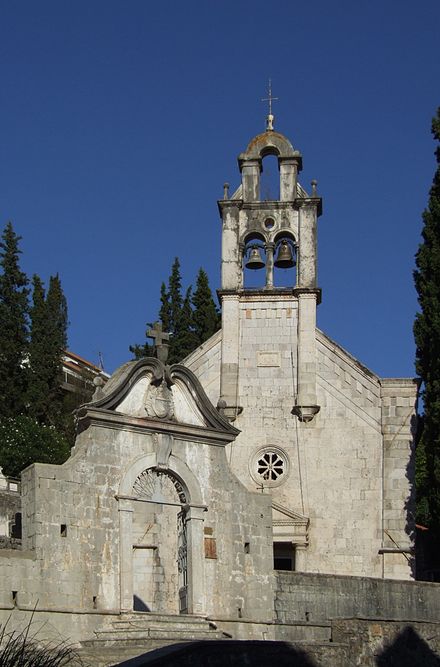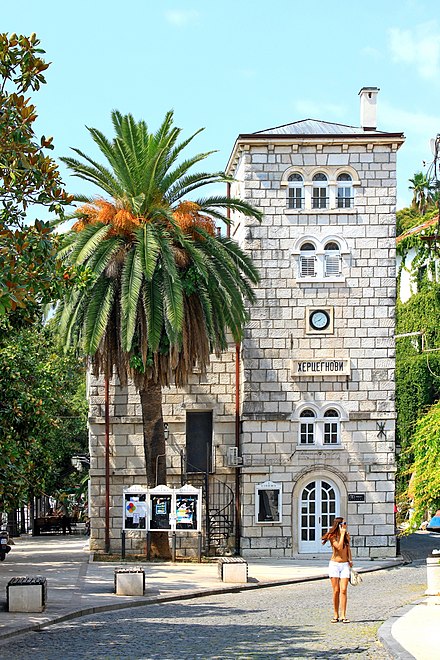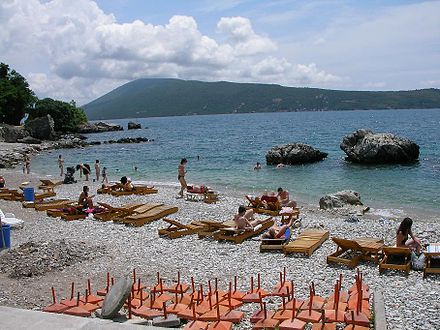Herceg Novi - city in Montenegro

Understand
Herceg Novi is a very popular destination for tourists from the neighbouring Serbia, and, to a lesser extent from Russia. In spite of this tourist boom, the city has managed to some extent to keep the traditional slow Montenegrin lifestyle. The locals are very welcoming and you are never annoyed by street vendors.
A sizeable Bosnian (Serb) refugee population flooded into Herceg Novi during the war years. Many of the camps are still around although they have been turned into more permanent (and quite nice) settlements. You can still see them on the bus as you leave the city. Also if you go for a wander up into the hills you will come into whole new areas of construction resulting from a property boom.
The Financial Times in 2007 listed Montenegro as one of world's 10 top property hotspots and foreign buyers have been snapping up properties on the coast.
Get in
Bus is the only form of public transport in/out of Herceg Novi, and the bus station (located in the centre of town) is busy the day long with buses heading (mostly) down the Adriatic coast. There is a regular bus service to Herceg Novi (and further to other Montenegrin cities) from main bus station in Dubrovnik, which runs several times a day. It costs €11 (October 2017) and takes about one hour. There are also regular buses to Kotor, Budva, Bar and Podgorica. Some buses go as far as to Beograd.
If Herceg Novi is your main destination, a pleasant alternative to bus travel is hiring a Croat cab from Dubrovnik airport (Cilipi) for about €50; this trip takes about 40 minutes, including border crossings.
There is no rail or ferry access into the town.
Get around
On foot as the city is not big. There are also regular public transport buses but you'll need to check those at the bus station.
See

- The Herceg Novi old town is amazing. It is on a fairly steep hill that leads all the way down to the sea. Wandering through the small stairways to the various plazas and fortresses is a many hour adventure. There are both Orthodox and Catholic churches that are well worth visiting.
- The Kanli Kula fortress dominating the old town doubles as an open-air theatre and is worth visiting mainly for the splendid views of the town and the Kotor bay (entrance fee as of August 2012: €1; free for children under 12)
- The Spanjola fortress higher up the mountain (170 m above sea level) dates back to 16th century. Take a small street going upwards across from the Kanli Kula fortress. Entrance is free and you can freely climb (and fall from) the walls.
- The Savina monastery, approximately 2 km east from the city center has three beautiful Orthodox churches and (yet again) splendid views of the bay.
- The fortress "Forte Mare" regularly shows films at night.
Do
- Swimming - The city has some great pebble and many concrete beaches, although most of them are quite crowded during high season (see photo). There is a path that leads along the beach part of the city for about 3 miles. Follow it until you find a place that is suitable for you. Many small privately owned beaches have loungers, small boats, and other gear for hire.
- Mud therapy - At the western end of the promenade is a small spa town of Igalo, renowned across Europe for healing properties of its muddy, mildly radioactive sand. A health and hospital centre complex offers mud therapy combined with other treatments, but you can do it yourself by following the locals and wading through the sand. Apply the muddy sand all over your body, or on affected parts, and combine with gentle exercise and sunbathing for best effects. This is believed to be beneficial for rheumatic complaints, skin disorders, and gynecological problems.
- People watching - Along the promenade, the main square in the Old Town, and almost everywhere else around town, there are about hundred small cafes with tables conveniently positioned for this popular local pastime. All serve good coffee (Italian style) and many also offer a selection of freshly made and delicious cakes and ice creams.
- Hiking - Going from the bus station up towards the hills you can find some wonderful ancient stone paths that lead up to some very rural communities. The paths are not marked and not very visible but if you wander along any road for a mile or so and keep an eye on the vegetation you should find one. Either way take a 5- to 6.5-km walk up into the hills (whether you find the paths or not).
- Mountaineering - Get in touch with Herceg Novi based mountaineering society "Subra" if you are serious about mountain sports in some of the most beautiful and unspoiled mountains in Europe.
Buy
Italian-made clothes in Old Town and Igalo boutiques are reasonably priced up-to-minute fashions. Not great for local arts and crafts, which are available in Kotor and Budva. Go to local market just off the main square in the Old Town on Saturday morning to buy fresh fruit (sweet and cheap), olive oil, sheep and goats cheese, dried figs, locally made wine; this market sells seasonal and locally produced goods, so what you find depends on the time of your visit.
Eat
 Go to small eateries around the promenade for fresh local food, grilled seafood and meat dishes, and international cuisine. Count approximately €10-12 for the main dish in a typical restaurant (grilled high-quality fish is more expensive). Almost all cafes serve pizza which is usually well-made. Follow the locals; Montenegrins are usually more picky than foreign tourists when it comes to eating out.
Go to small eateries around the promenade for fresh local food, grilled seafood and meat dishes, and international cuisine. Count approximately €10-12 for the main dish in a typical restaurant (grilled high-quality fish is more expensive). Almost all cafes serve pizza which is usually well-made. Follow the locals; Montenegrins are usually more picky than foreign tourists when it comes to eating out.
The Petica in the centre of the Old Town is a great place to sit, drink an espresso, or have some fairly priced pasta/pizza. 4-7E. The service is very friendly and the food is delicious.
The Tre Lipe restaurant is next to the Sea Fort (Forte Mare), 20 m from the beach. You eat in an open-air terrasse under three old lindens, and the service is quick and friendly.
Drink
Herceg Novi is hot in summer, and it usually stays warm late into the evenings, so cold drinks are best sellers. Iced coffee is served in tall glasses with dolops of ice cream and "slag" (fatty whipped cream) and qualifies as a full meal. Local beer made in Niksic is good; also try "spritzer" which is a refreshing mix of chilled white wine and carbonated mineral water.
Sleep
Accommodation is plentiful: Look for signs that say 'soba.' You should be able to get a room for €10 per person during the summer months.
Go next
Half-day or full-day boat excursions along the Kotor bay or to a specific destination (Kotor, Perast, Ostrog monastery) leave from different points on the beach.
Herceg Novi
Primary administrative division

